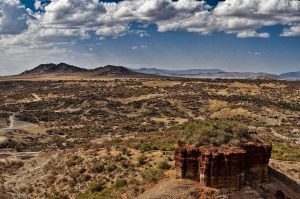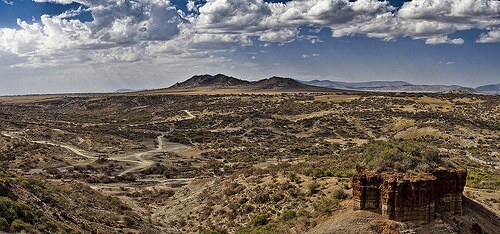
Plant molecular fossils reveal details of an early human habitat at Olduvai Gorge, including the critical freshwater and plant resources available to early humans, according to a study conducted by an international team led by Clayton Magill of the Geological Institute in Zurich, Switzerland*. Fossil evidence showing how early humans coexisted with critical plant and water resources is scant. As a result, how such local resources affected early human evolution remains unclear. To study the meter-scale spatial distribution of these resources, Magill and colleagues excavated 71 buried soil samples across a 25,000-square-meter area at a nearly 2-million-year-old Olduvai Gorge archaeological site. Different types of plants each have their own characteristic chemical biomarkers preserved in the soil. The authors analyzed these biomarkers to distinguish between co-occurring plant types. The biomarker evidence indicated a varied landscape containing different types of vegetation, including the presence of a woodland thicket near a small freshwater wetland, all surrounded by an open grassland landscape. This finding suggests that early humans living at Olduvai Gorge had reliable and easy access to potable water, edible plants, and aquatic animals. The thicketed area delineated by biomarkers also contained butchered animal bones and early human remains. According to the authors, early humans may have brought animal remains and food from the surrounding grasslands or wetlands to the wooded habitat, which may have provided protection and access to freshwater.
________________________________________
View of Olduvai Gorge, Tanzania. Noel Feans, Wikimedia Commons
______________________________________________________
The study is published in the Proceedings of the National Academy of Sciences (PNAS).
Source: Edited and adapted from the subject PNAS press release.
______________________________________________________
*“Dietary options and behavior suggested by plant biomarker evidence in an early human habitat,” by Clayton R. Magill et al.
______________________________________________________
______________________________________________
Travel and learn with Far Horizons.
____________________________________________
This richly illustrated issue includes the following stories: Recent findings shedding new light on the whereabouts of the remains of Philip of Macedon, father of Alexander the Great; how an archaeologist-sculptor is bringing bones of the dead back to life; archaeologists uncovering town life at the dawn of civilization; an exclusive interview with internationally acclaimed archaeologist James M. Adovasio about what makes the Meadowcroft Rockshelter prominent in the ongoing search for the first Americans; what archaeologists are finding at the site of the ancient city of Gath, the home town of the biblical Philistine giant, Goliath; and how scientists are redrawing the picture of human evolution in Europe. Find it on Amazon.com.









